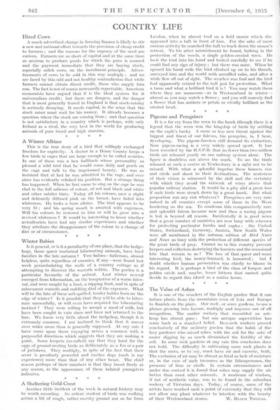Pigeons and Peregrines It is a far cry from the
wren to the hawk (though there is a legend that the wren won the kingship of birds by settling on the eagle's back). A more or less new threat against the biggest and finest of our falcons, the peregrine, is, I hear, developing. The pigeon-fanciers still demand its extinction. Now pigeon-racing is a very widely spread sport. It has been recorded by the R.S.P.B. that no fewer than two million birds are released yearly on one railway system alone. The, figure is doubtless not above the mark. To see the birds released at such a centre as Tewkesbury is a sight not to be, missed. With what a splendid impetus these homers rise. and circle and shoot to their destinations. The acuteness of their vision is witnessed by the skill and the certainty with which they avoid the network of wires above that popular railway station. It would be a pity and a great loss if such birds were struck doWn by a great hawk. But what proportion run any risk whatever ? Peregrines are very rare indeed in all counties except some of those in the West bordering on the sea. To condemn this comparatively rare and splendid falcon because now and then a racing pigeon is lost is beyond all reason. Incidentally it is good news that a great number of countries are now busy with schemes. for protecting particular hawks and eagles : the United States, Switzerland, qermany, Austria, New South Wales were all mentioned in the autumn edition of Bird Notes and News as busy with the protection of different species of' the great birds of prey.. Cannot we in this country prevent keepers and collectors destroying the harriers and the occasional kite that remain to us ? The loss of that queer and most interesting bird, the honey-buzzard, is lamented ; but doubt whether human persecution was chiefly to blame in his regard. It is perhaps a bird of the class of hoopoe and golden oriole and, maybe, lesser bittern that cannot quite decide to regard this island as a native home.
* * * *












































 Previous page
Previous page